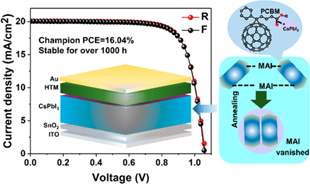Mediator–antisolvent strategy to stabilize all-inorganic CsPbI3 for perovskite solar cells with efficiency exceeding 16%
| Reviews and Highlights | Quantum Science | Molecular and Soft-matter | Ultrafast Nano-optics and Nanophotonics | Mineralogy and Geochemistry |
|---|
Ting Zhang, Feng Wang, Hao Chen, Long Ji, Yafei Wang, Chun Li, Markus B. Raschke, and Shibin Li
ACS Energy Lett. 5, 1619 (2020).
DOI PDF

All-inorganic cesium lead triiodide (CsPbI3) perovskites have attracted much attention because of their intrinsic chemical stability and suitable bandgap for photovoltaic applications. However, simple methods to synthesize pure CsPbI3 have been limited. Here, we develop a new mediator–antisolvent strategy (MAS) combining phenyl-C61-butyric acid methyl ester (PCBM) blended chlorobenzene (CBZ) antisolvent and methylammonium iodide (MAI) mediator to synthesize high-quality and stable black-phase CsPbI3 perovskite films. The crystallization process is altered by the blended antisolvent, leading to a smaller crystallite of the perovskite with improved stability. The small amount of MAI acts as mediator and further improves the quality of the CsPbI3 films in morphology and photoelectronic properties. Finally, the power conversion efficiency of CsPbI3 perovskite solar cells prepared by the strategy significantly increases to a value of ≥16% with good reproducibility. Moreover, the devices retain 95% of their original efficiency over 1000 h.
